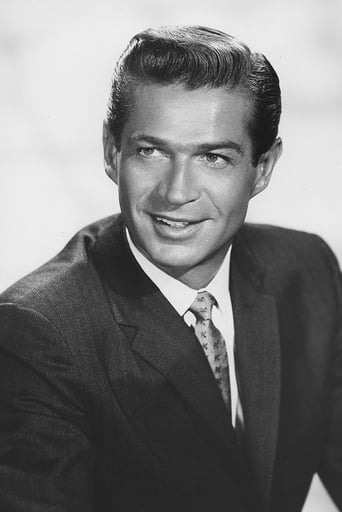Mjeteconer
Just perfect...
Murphy Howard
I enjoyed watching this film and would recommend other to give it a try , (as I am) but this movie, although enjoyable to watch due to the better than average acting fails to add anything new to its storyline that is all too familiar to these types of movies.
Erica Derrick
By the time the dramatic fireworks start popping off, each one feels earned.
MartinHafer
"Away All Boats" is a very good war film that celebrates the work of a WWII Attack Transport ship, the PA 22 'Belinda'. While the ship itself is fictional, it does a great service to the boats just like it-- boats that served with distinction even though they weren't the 'prestige' ships, such as cruiser, battleships and the like. Unfortunately, I'd like to score this one higher but can't...and I'll get to that in a bit. When the film begins, the new skipper of the ship, Captain Hawks (Jeff Chandler) arrives aboard the Belinda. What follows is the story of how the Captain took a crew of mostly inexperienced seamen and turned them into an efficient fighting force. It follows them from their rocky beginning to their first battles to the ship's, as well as the Captain's, last.The film is exciting and works well...mostly. I loved how the film humanized the men but also celebrated their exploits in a realistic and exciting manner. BUT, there is a small portion of the film that simply doesn't fit at all and was obviously tossed in later...and had nothing to do with the picture!!! At one point, one of the crew members starts thinking about his wife...and you see a montage with irrelevant footage of one of Universal's newest starlets, Julie Adams. And, for this unimportant and small portion, Adams received billing way above many of the talented actors that actually belonged in the film! I can only assume some bone-headed exec thought 'we got a war movie with only guys...we need a woman in order to attract female viewers' and thus the Adams sequence. Dumb and sad because without it the film would have earned at least an 8. The film is quite well made and tense...and reminiscent of an excellent film made around the same time, "Run Silent, Run Deep".
gordonl56
AWAY ALL BOATS – 1956This is one of the better WW2 films about the unglamourous part played by the US Navy attack transport craft. These were the ships that moved the troops up to the landing beaches, then launched the landing craft that carried troops to said beach. This one starts in San Diego Navy yard with a new crew reporting to a just fitted out transport. The story is told mostly from the view of the new third in command officer, George Nader. Nader is an ex-Merchant Marine Captain that took a double rank drop to join the Navy. The new Captain is Navy veteran, Jeff Chandler, whose last ship had been sunk under him. Also in the cast as officers are Lex Barker, Richard Boone, Keith Andes and Charles McGraw. Other than Chandler, Boone, Nader and some of the below decks chiefs, everyone is new to the sea. Chandler takes the new ship out for a shakedown cruise to Pearl Harbour. He pushes the men hard and heavy to see how they take it. Sick bay is soon full with sea-sick types and various bumps and cuts. The heavy work load though does cause the men to learn their jobs. Once at Pearl Harbour, the ship is loaded with Marines and more training is needed. Once that is done, the ship heads for the war zone. First up is Japanese held Makin, then Kwajalein and so on through the Pacific. Several of the crew distinguish themselves while others are found lacking in ability and courage. Morale takes a big hit when the mail is constantly sent to the wrong place, and no liberty ports. The men are always at each other and fights become a routine daily event. Chandler steps in and orders the construction of a small 14 foot sailboat. Soon all the men are upset at the Captain instead of each other. But morale goes up as the Captain takes out the small craft out for a spin whenever they are at anchor. It is now April 1945 and the Invasion of Okinawa. The Japanese Army and Navy Air Forces are hurling hundreds of Kamikaze aircraft at the invasion fleet. The ships on picket line duty and the Combat Air Patrol take care of most of these. However, they are often overwhelmed and the fleet comes under attack. Everything the fleet can fire throws up as much flak as possible, but some aircraft still get through. The transport is hit several times and badly damaged. As the ship is being repaired, another attack of Kamikaze breaks through the CAP. A bomb laden Zero fighter hits the ship at the waterline, holing her. The Captain, Jeff Chandler is severally wounded and command falls to Nader.The ship is ordered to withdraw out of the combat area. Things now go from bad to worse, as the ship loses its propeller. The ship is also slowly filling with sea water and is in danger of rolling over and swamping. Needless to say the remaining crew work like demons to effect repairs to the hole in the side. They then launch the few landing craft to survive the air attacks. These are used to tow the ship from the danger area. Chandler sees that the ship will be saved, then dies.While there is the odd slow bit, the film as a whole is quite entertaining. It is interesting to see a film showing duty in a rather unheralded area of Naval combat. The action scenes are quite well done considering the era the film was produced. Look close and you will see an unbilled Clint Eastwood in several scenes. I also saw stunt-men turned actors, Charles Horvath and Bobby Hoy in small roles. .
brianshoebridge1
At the opening scene this movie feels like a wartime morale flick but it quickly moves past that. I like that it gives us a story that is seldom told, namely that of a heavy troop landing ship. Reminds me of the HMAS Tobruk I spent some time on in the 80s. The "Belinda" is a work boat, not a glamorous warship & the spartan conditions aboard reflect that. As the ship was newly built it is reasonable that the sets all look spic'n'span.Overall it is a well made war film with a strong cast of good character actors. As others note, special effects clearly developed quite quickly in the 1945-55 period. Time well spent.
Robert J. Maxwell
It's the story of the USS Belinda, an attack transport, whose mission is to take Marines and soldiers to the beaches of the Pacific and land them, usually under fire. And it's not badly done.Jeff Chandler is the necessary tough but fair captain of the Belinda. He remains isolated from the men throughout, as he must, since he's in command, and must whip the new sailors and officers into shape. As in every other war movie you can think of, he must be cruel to be kind.The exception to this formula is "The Caine Mutiny," in which the crew are seasoned and efficient, while the new commanding officer is petty, incompetent, and half nuts.Be that as it may, the film has some good things going for it. One is the photography by William Daniels. The shots aboard and around the ship are convincing. When you watch the Belinda from the air, you see a real Navy transport, suffering a real list, emitting real smoke from its damaged deck, and being towed by real LCVPs. The combat scenes are model work but reasonably effective. Especially impressive are the special effects used during the Kamikaze attacks at Okinawa. The tiny suicide airplanes in the distance are gradually enveloped in exact replicas of the small blotches of exploding 40 millimeter shells, as if the far-off sky were erupting in dozens of black freckles. And, as a bonus, they aren't accompanied at first by loud bangs on the sound track because, as in real life, they're too distant for the noise to register. A fine and convincing job that required some thought. Not too much, but some.Jeff Chandler is reliable without being memorable. George Nader as the only other experienced seaman aboard is the audience proxy and does a professional job, as do most of the supporting cast, especially Charles McGraw as the Beachmaster and Richard Boone, as the manly but unforgiving Lieutenant Fraser. Even Lex Barker, the ex Tarzan, pulls off his role as the ineffective executive officer enacts his role with aplomb, though, according to Boone, who holds him in contempt, he has nothing but good manners and a toothpaste smile. Barker retains both features as he "grows into his stripes" and finally qualifies for his own command, although his maturation is no more than mentioned, rather than illustrated. Some of the minor roles are embarrassingly bad. The chicken grinder should have stuck to grinding chicken guts. And Ensign Twitchell, who has the mind and temper of a spoiled ten-year-old overplays a part that is already over-written.I rather like it, too, because it's the story of an unglamorous ship, an Attack Transport. There are lots of movies about carriers and destroyers, but none others that I know of that deal with APAs, some of which were manned by U. S. Coast Guard personnel. Finally, the most tense sequences, aside from the Kamikaze attacks, deal with the salvage of the half wrecked Belinda. There are no exciting moments imposed on the narrative by a landing party armed with Tommy guns. There is, though, a rather extended flashback involving Nader's courtship of Julie Adams. It's only saving grace is that, amidst the torpid romance, Julie Adams is on display for a few minutes in an appealing white swim suit. And she is an elegant-looking dish.




